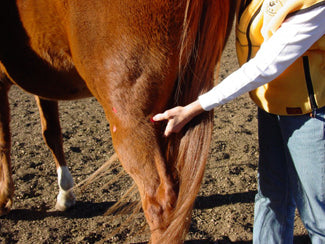Bladder 40 (Bl 40), or Urinary Bladder 40
Pinyin Name – Wei Zhong
English Translations – Entrusting Middle, Supporting Middle, Bend Middle,
Middle of the Crook
Bladder 40 is a commonly used acupoint in many complementary bodywork therapies including acupressure, acupuncture, ayurvedic medicine, Thai massage, Tibetan medicine, and Trigger Point Therapy. Because all of these medicines were derived from the rich resource of Chi Gong and traveled the Silk Road into other cultures, Bladder 40, as well as other acupoints, is used in so many therapies. The interesting thing to note is that all of these therapies use this acupoint for similar purposes.
Acupoint Classifications
Bladder 40 is the He-Sea point for the Bladder meridian. This means it’s the acupoint that leads the chi flow into the “sea” of the body. There’s a series of acupoints beginning with the Jing-Well point, Bladder 67 (Bl 67) of the Bladder meridian, where the well of chi bubbles up and begins its flow of chi along the meridian. Bl 40 is the last point where chi collects before flowing into the larger sea of chi in the body.
Bladder 40 is considered the Earth Point on the Bladder meridian according to the Five-Element Theory (aka “Five Phases of Transformation”). Bl 40 is the Earth Command point, and thus represents the properties of Earth within the Bladder meridian. This is where Earth energy emanates along the Bladder meridian.
Bladder 40 is the Master point for the animal’s hindquarters. Master points benefit a physical region of the body and are included in acupressure sessions to enhance the effect of the session when there’s an issue related to a particular location.
Energetic Actions
Bladder 40 benefits the animal’s hindquarters, relieves pain, clears Heat, resolves Dampness, cools blood, clears Summer Heat, and activates the Bladder meridian.
Indicators / Clinical Signs
Bladder 40 can be included in acupressure sessions when the animal presents with any of following indicators or clinical signs:
Acute or chronic hindquarter weakness, muscle atrophy, paralysis, pain, spasms, or motor impairment
Abdominal pain, rebellious Stomach chi, or diarrhea
Enuresis (i.e., involuntary urination), dysuria (i.e., difficult or painful urination), or dark urination
Location
Equine – Located at the midpoint of the transverse crease of the popliteal fossa between the semitendinosus and biceps femoris muscles. Press in from the back of the horses stifle.

Canine & Feline – Located at the midpoint of the transverse crease of the popliteal fossa. Press in from the back or the dog or cat’s stifle.


